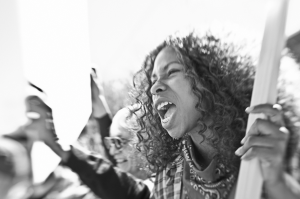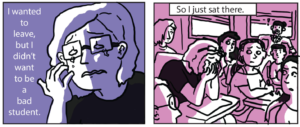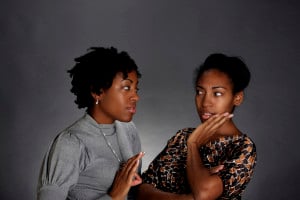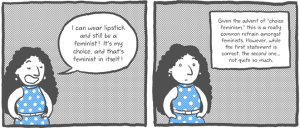
A person stands, appearing determined, with a crowd out of focus behind them.
Growing up in the suburbs of southern California, there were a lot of ways that I was encouraged to believe in nonviolence; specifically the non-violence that was about maintaining order and dignity.
Hitting other children would, of course, mean that I was punished. I never did get into a fight, because I was a child who knew how to perform for authority figures while hating them at the same time.
But I had a habit of imagining scenarios in which I’d have to physically protect myself – which maybe developed because I was a feminine child coerced into “acting like a boy.”
I would rile myself up with these scenarios and picture myself kicking the shit out of someone with my tiny, five-year-old legs. I’d see myself dodging punches and jabbing back with an elbow.
These scenarios made me feel fierce, like I had some kind of agency over my body.
Even so, I felt that violence was deeply wrong, even if I couldn’t articulate why. I understood it as a moral issue: the bad people are violent, the good ones are peaceful.
This applied no matter what the context was.
I believe this is how some of our concepts of violence become twisted, to our own disadvantage. In retrospect, there wasn’t any room to talk about the violence enacted by these white women who were responsible for nurturing me.
They were surely violent – teaching me about Native Americans as a homogeneous group, rather than as hundreds of distinct nations, and rendering them exotic and extinct. The lesson plan taught me how to weave a basket but not about the enslavement and ongoing abuse of the Kizh Nation.
It wasn’t until I became more active on Twitter – which can be a platform for self-education outside of academic institutions that usually don’t operate in the best interests of marginalized groups – that I began to understand things like power dynamics and how violence is not just a question of who threw the first punch.
From there, I began to be exposed to the work of Malcolm X and Frantz Fanon. I started to read up on slave rebellions and anti-colonial movements. From the vital work of generations past, for which I am eternally grateful, I’m now able to see how many myths surround violence.
When we believe in these myths, we can unintentionally be working against ourselves.
Myth #1: All Violence Is the Same
Um, no. Me throwing a punch at my baby cousin is not like my baby cousin trying to fight me.
Context matters – the situation and people involved have to be taken into account. Power dynamics have to be considered – who has more resources to leverage, who has more to lose, who has the capacity to inflict more harm?
Violence is often leveraged across inequities in order to maintain the status quo. The violence enacted by someone from an oppressive group cannot be said to be similar to that of the oppressed.
The violence that marginalized people face from police for example, especially those who are Indigenous and/or Black, is never comparable to any counter-violence.
Police forces in the US started as slave patrols and settler militias set on maintaining slavery and killing Indigenous people for their land. The police is an institution that protects the interests of the state; history tells us why the two groups that are routinely murdered at the highest rates are Indigenous and Black people.
People who fight back against police are practicing resistance. If this resistance could be called violent, it pales in comparison to a centuries-old practice that systematically targets Indigenous and Black people. It’s like throwing a pebble at a brick wall.
The people trying to get free cannot be perceived in the same light as the people trying to kill them.
In fact, some of the instances where people have fought back with force have been celebrated – the Stonewall Riots, for example, laid some of the foundation for movement-building of the present day. People like Sylvia Rivera and Marsha P. Johnson fought back with force, a response that is only natural considering how much pain they endured from those who were paid to “serve and protect.”
We can also look at this on an interpersonal level. Women and non-binary femmes who have fought back against street harassment and intimate partner violence are not the same as their abusers. They have a right to survive.
Yet, many of these women are caged in prisons, where they face additional violence, when they defend their lives.
Counter-violence is often necessary to stay alive. The death toll may be higher if those being attacked didn’t strike the fuck back.
The genocide of Indigenous nations, for instance, would have been complete if there weren’t armed resistance movements and coalitions.
Myth #2: Violence Is Only Physical
Laverne Cox said in 2014 that “when a trans woman is called a man, that is an act of violence.”
(She’s right, of course.)
Trans women die at the hands of people who believe this, who believe that they aren’t valid or real. That they’re pretenders, dangerous impostors.
When a trans woman is called a man, the culture that threatens trans women’s lives is reinforced. Many trans women of color barely make it past their 30s; their average age of death mirrors the life expectancy of a baby born more than 5000 years ago.
When people support the conditions that create violence, they are also committing violence. They’re simply ensuring that someone else will be doing the work of murder.
Other ways this happens is when a textbook says “workers” in reference to chattel slaves, diluting the degree of violence done to people abducted from West Africa.
It also happens when people seem to forget that disabled people of color exist (#DisabilityTooWhite). And when people say #AllLivesMatter and derail from the focus on Black lives being snuffed out by police and prisons – they’re willing to hurt Black people even in death.
Non-physical violence is always underestimated.
It’s violent when people are made to speak English as Indigenous languages disappear. It’s violent when people are made to believe that they can only be either a man or a woman. And it’s violent when land is desecrated in the name of scientific research.
All of these forms of non-physical violence fuel death and destruction. They destabilize communities and stifle cultures, which leads marginalized communities to commit violence amongst themselves.
Non-physical violence can lead people to take their own lives. And when trans youth take their lives, it is an act of violence from the people, including government officials, who uphold a transphobic culture.
When I see how many Vietnamese people are still living with chronic illness and PTSD from Americans raping, pillaging, and bringing destruction upon people, animals, and the land, I have no doubt in my mind that it is violence. Generations of birth defects, as a legacy of war, is violence.
And yet, people still believed the oppressed need to be nonviolent in the face of violence at every turn.
Myth #3: Protesters Must Remain Non-Violent for Their Cause to Have Credibility
This argument is such utter bullshit that sometimes I just refuse to engage with people who spew this.
So many of the people alive right now just wouldn’t have been born if their ancestors didn’t kill their conquerors.
People from groups with power are allowed to be violent in so many ways while the disempowered are expected to be picture perfect.
Tell me why Dylann Roof was treated to Burger King after killing nine Black people at a bible study, while Korryn Gaines was murdered and had her five-year-old shot after a SWAT team invaded her home for traffic violations.
There has been daily evidence of police officers killing people left and right, but people are still clamoring to humanize cops with #BlueLivesMatter and “what about the good ones?”
Meanwhile, people are saying that Korryn Gaines deserved to die for carrying a weapon that she legally purchased to defend herself from threats. Where is the humanity that people so generously give to the police?
There are ridiculous standards placed on people who are involved in resistance; they’re not given any room to express their rage and grief however they see fit. Protesters are placed under a magnifying glass from the get-go, while people will go to great lengths to absolve Hillary Clinton of the unbelievable horror she has brought into the world.
The only kinds of protests that the majority of people seem to approve of are the ones that look good on TV – the ones perceived as dignified and respectable. I mean, Hillary Clinton looks pretty respectable in that pantsuit, but there are quite a few bloodstains she’s washed off that polyester. Trust me.
The time and energy spent scrutinizing protesters could instead be spent scrutinizing the people killing the protesters.
Myth #4: Activist Figures of the Past Would Disapprove of Violent Movements of the Present
People like to pick and choose the activist figures that best serve their interests.
People who uses Martin Luther King’s name to silence Black people usually aren’t invested in Black liberation or in learning about Dr. King’s anti-imperialist values. People who have Gandhi’s name on call usually aren’t trying to decolonize the U.S. like Gandhi helped decolonize India.
These two figures have been sanitized and twisted for the benefit of people who distort their legacies.
Dr. King was more radical than many people would like to believe. He was critical of capitalism and advocated for reproductive justice.
Gandhi, on the other hand, undermined his anti-colonial politics by spouting hateful comments about Africans.
If your reservations about violence are because certain historical figures might disapprove, I urge you to do more research about them. And then I’d suggest you think for yourself.
Because there are also many figures who have been less palatable to people looking for a legacy to manipulate.
Kwame Ture, for example, has brilliantly explained, “In order for nonviolence to work, your opponent must have a conscience. The United States has none.”
We can also look to Leila Khaled of the Popular Front for the Liberation of Palestine, Blanca Canales of the Puerto Rican Nationalist Party, and Lakshmi Sahgal of the Indian independence movement for reminders that resistance is not just limited to non-violence.
Just as in the present, there are people of the past who opposed violence and those who were willing to use violence. We should be able to learn from history without feeling obligated to choose a particular model to emulate.
Myth #5: We Have to Choose Between Violence and Non-Violence
There are situations where non-violence may work better than violence and vice versa.
Having to choose resolutely between one or the other is not a choice we have to make.
Systems of oppression evolve over time and we need all the tools we can get. Everyone should be free to choose the tactics that they feel most comfortable with.
For someone who has PTSD, violence might be triggering. A lot of marginalized folks have enough instability in their lives; they can choose not to invite more chaos.
A physically disabled person, depending on their disability, might only be able to engage in militant resistance by acting as a home base for communication or by dispersing information, all of which is just as vital as being in the streets.
The unnecessary binary of violence and non-violence creates a divide among people who might be on the same side. The divide between the two tactics can make it seem like one will work while the other will fail, when we really we could be using both.
***
I don’t intend to romanticize revolution and call for the kind of militancy that is photogenic enough to repost on social media. I’m unsure of what revolution could look like myself.
What I’m demanding here is our right to destroy what destroys us.
[do_widget id=’text-101′]
xoài phạm is a Contributing Writer for Everyday Feminism. They are a Vietnamese femme. They are tender and dangerous. They love mangos. They have places to be and people to scare. Read their articles here.
Search our 3000+ articles!
Read our articles about:
Our online racial justice training
Used by hundreds of universities, non-profits, and businesses.
Click to learn more
Most Read Articles
- « Previous
- 1
- …
- 30
- 31
- 32




















